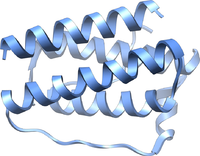
Photo from wikipedia
Pregnancy and lactation-associated osteoporosis (PLO) is a rare skeletal disorder characterized by early-onset osteoporosis typically manifestating with vertebral compression fractures or transient osteoporosis of the hip. We hypothesized that genetic… Click to show full abstract
Pregnancy and lactation-associated osteoporosis (PLO) is a rare skeletal disorder characterized by early-onset osteoporosis typically manifestating with vertebral compression fractures or transient osteoporosis of the hip. We hypothesized that genetic variants may play a role in the development of PLO. This study aimed to analyze the presence of genetic variants and a potential association with the clinical presentation in PLO. 42 women with PLO were included from 2013-2019 in a multicenter study in Germany. All cases underwent comprehensive genetic analysis based on a custom-designed gene panel including genes relevant for skeletal disorders. The skeletal status was assessed using dual-energy X-ray absorptiometry (DXA). Subgroups were further analyzed by serum bone turnover markers (n=31) and high-resolution peripheral computed tomography (HR-pQCT; n=23). We detected relevant genetic variants in 21 women (50%), with LRP5, WNT1 and COL1A1/A2 being the most commonly involved genes. The mean number of vertebral compression fractures was 3.3±3.4 per case with a significantly higher occurrence in the subgroup with genetic variants (4.8±3.7 vs. 1.8±2.3, p=0.02). Among the total cohort, DXA Z-scores were significantly lower at the lumbar spine compared to the femoral neck (p=0.002). HR-pQCT revealed a pronounced reduction of trabecular and cortical thickness, while trabecular number was within the reference range. Eighteen women (43%) received a bone-specific therapy (primarily teriparatide). Overall, a steep increase in bone mass (+37.7%) was observed after 3 years. In conclusion, pregnancy and lactation represent skeletal risk factors, which may unmask hereditary bone disorders leading to PLO. These cases were affected more severely. Although, a timely diagnosis and adequate treatment can ensure a substantial recovery potential even without specific therapy. Patients with genetically induced low bone turnover (e.g.; LRP5, WNT1) may especially benefit from osteo-anabolic medication.
Journal Title: Bone
Year Published: 2021
Link to full text (if available)
Share on Social Media: Sign Up to like & get
recommendations!